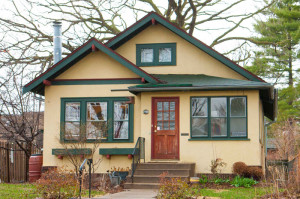Small Home Gazette, Spring 2014
Letter From the Editor: Kristi Johnson looks back 20 years
 It is astonishing to be able to write a 20th anniversary column for the Twin Cities Bungalow Club. Way back in the early ‘90s, we had the vision that our urban neighborhoods had the potential to turn out just as they have—with cool new restaurants, coffee shops, hair salons, grocery stores, revitalized garden stores and movie theaters, and tons of people walking, biking, strolling and rollerblading along the river and the parkways.
It is astonishing to be able to write a 20th anniversary column for the Twin Cities Bungalow Club. Way back in the early ‘90s, we had the vision that our urban neighborhoods had the potential to turn out just as they have—with cool new restaurants, coffee shops, hair salons, grocery stores, revitalized garden stores and movie theaters, and tons of people walking, biking, strolling and rollerblading along the river and the parkways.
While we could actually see restored bungalows, four-squares and “streetcar” business corners springing back to life again, many weren’t so sure. Studies had been undertaken indicating those often-empty brick, plate-glass and tile neighborhood hubs were a blight. They just didn’t work anymore. And the housing stock? Well, officially calling bungalows an “obsolescent” style of residential architecture in a Minneapolis Community Development Agency report didn’t help matters.
While others were casting about for ideas, we were looking back to a time when our houses and neighborhoods were built. We had our feet squarely planted in the history of the teens and 1920s, back when New Urbanism* was really new. Meanwhile, a large contingent seemed to harken back to the ‘70s as the touchstone: A time when housing sizes doubled, and everyone was scramming for split-levels in the suburbs.
But why were people leaving their terrific neighborhoods and cozy houses and rushing to the suburbs? Because of that incredible strip mall architecture and the feeling of coziness and culture and being able to drive everywhere—even to get a half gallon of milk? Were boxy split levels (the cheapest type of house to build) really the acme of residential architecture? Well, they were bigger.
The average home size in the 1950s was 983 square feet. A recent Census Bureau report put the average home size for new construction in 2013 at 2,647 square feet.
How do you compete with that?
You don’t. You look at what you have and how a home should fit into a community–city–state–world. That is what New Urbanism was addressing and it dawned on us, that the “streetcar suburbs” built just outside the downtown city center—when people relied on walking and public transportation— comprised all that New Urbanism was extolling. They already existed, the entire infrastructure was there, and the housing stock was incredible and affordable! Once you walked past the modest exterior into a Minneapolis bungalow, you walked into a wealth of old-growth wood, tile, texture and design. The “wow” factor was still there. You couldn’t build one 20 years ago for half a million. You couldn’t afford the original materials.
So what was the problem?
Perception.
We knew we were competing with Parade of Homes and everything that shilled for newer and bigger. Housing starts—the number of new homes being built—is still a measure of a healthy economy, not a measure of waste. We knew we were dealing with the perception of the scary “inner city” rather than the reality of our actual healthy, walkable, wonderful neighborhoods. People honestly believed that it was more likely their child would be kidnapped by a crazed drug addict in Minneapolis than be killed or maimed in a car accident driving to and from their new home in Lakeville.
Perception.

Birthplace of the Twin Cities Bungalow Club—Kristi Johnson’s bungalow in the Longfellow neighborhood of Minneapolis.
So, call it a Craftsman bungalow or call it a “starter home.” Call it your neighborhood, or call it the “inner city.” Focus on what made these houses and walkable neighborhoods great, democratic and diverse—as they were built to be—or drive in the traffic jams home to your new executive model at Quail Run Heights. Buy into the idea that new and big is always better and that life is best lived in a car.
The bigger is better mantra has gotten a serious second look, at least in hip urban cities like Minneapolis and St. Paul. We knew it was wrong, and the Millennials and hipsters knew it was wrong from the get-go. The kids are back; the (obsolescent) shuttered elementary schools are opening back up; and spring is in the air.
Of course there is always more to do, but let’s take this moment to sit back in our Morris chairs and raise a glass to us—the Bungalow Club people. To those who were able to hold onto the past and meld it to a sweet future. I guess today we’d be called change agents. We don’t hole up in our homes; we live in them. We are members of our communities, and we appreciate the good stuff in life—gardens, coffee shops, libraries, local schools and our neighbors. Sometimes that good stuff is old, and sometimes it is small, and yet it still works, and it is still beautiful when it does.
*Wikipedia: New Urbanism is an urban design movement which promotes walkable neighborhoods containing a range of housing and job types. It arose in the United States in the early 1980s and has gradually informed many aspects of real estate development, urban planning, and municipal land-use strategies. New Urbanism is strongly influenced by urban design standards that were prominent until the rise of the automobile in the mid-20th century; it encompasses principles such as traditional neighborhood design and transit-oriented development. It is also closely related to regionalism, environmentalism and the broader concept of smart growth.











